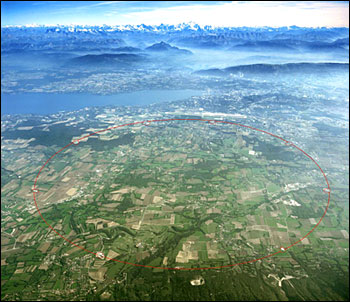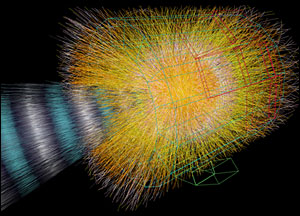
Threats Won't Stop Collider
Despite death threats, lawsuits, and even physicist Stephen Hawking betting against it, the Large Hadron Collider, the world's largest particle accelerator, will be turned on Wednesday.
The LHC operates in a circular tunnel 27 km (16.7 miles) in circumference, buried around 50 to 175 m underground and straddling the Swiss and French borders on the outskirts of Geneva. The accelerator was originally conceived in the 1980s and approved for construction in late 1994. The project cost more than $8 billion.
The LHC is expected to provide new insights into the mysteries of the universe through some of the tiniest objects in nature: protons, neutrons, electrons and quarks.

The area under which the 16.7-mile tunnel for CERN's LHC (outlined in red) can be found is shown near Geneva and Lake Geneva. The French Alps and Mont Blanc can be seen in the background. (Photo: Copyright ©CERN)
When protons arrive in the LHC they are travelling at close to the speed of light. Each proton goes around the ring over 11,000 times a second as they move inside vacuum chambers which pass through 9600 magnets. The particles' collisions will simulate conditions shortly after the Big Bang to help scientists discover how the universe evolved.
Almost since the beginning there have been concerns that it will turn out to be a "doomsday" device, generating universe-swallowing massive black holes (For a dramatic video simulation of such a scenario posted on YouTube, click here).
According to media reports, scientists working on the accelerator at CERN (the European Organization for Nuclear Research), including Nobel Prize-winning physicist Frank Wilczek of the Massachusetts Institute of Technology, have received threatening e-mails and worried phone calls from those fearful that turning on the collider will somehow bring about Armageddon.
In March, Hawaii residents Walter Wagner, a former nuclear safety officer, and Luis Sancho filed a lawsuit in Hawaii's US District Court seeking a restraining order to stall the LHC while its safety was reassessed; that case is still working its way through the court. German chemistry professor Otto Rössler of the University of Tübingen filed an emergency injunction with the European Court of Human Rights to stop the project.
The court rejected Rössler's appeal, but the theoretical chemist said he still believes that a mini black hole could "eat the planet from the inside" within four years of forming.
On Tuesday, Romania's Conservative Party announced that it would protest before the European Commission mission to Bucharest starting at noon today, calling that the experiment be halted. The comments resulted in mockery by Romanian media, which compared the "tiny black holes" with the small size of the Conservative Party.
Numerous reports have been done on the collider's safety over the years, with the most recent, released last week, finding that fears about annihilating the planet are unfounded. On Sept. 5 the Institute of Physics (IOP) published a report in the Journal of Physics G: Nuclear and Particle Physics that it said provides the most comprehensive evidence available to confirm that the LHC, once operational, poses no threat to mankind.
The LHC Safety Assessment Group reviewed and updated a study first completed in 2003, which sought to dispel fears of black holes and other possibly dangerous new forms of matter. The report said that if particle collisions at the LHC had the power to destroy the Earth, mankind would never have been given the chance to exist, because regular interactions with more energetic cosmic rays would already have destroyed the Earth or other astronomical bodies.
The group compares the rates of cosmic rays that bombard Earth, other planets in our solar system, the sun and all the other stars in the universe itself to show that hypothetical black holes or strangelets, that have raised fears in some, will in fact pose no threat.

A simulation of a lead-ion collision in ALICE (A Large Ion Collider), a detector specializing in analyzing such collisions and one of six experiments installed at the LHC. ALICE will study the properties of quark-gluon plasma, a state of matter where quarks and gluons, under conditions of very high temperatures and densities, are no longer confined inside hadrons. (Photo: Copyright ©CERN)
The report also concludes that, since cosmic-ray collisions are more energetic than those in the LHC, but are incapable of producing vacuum bubbles or dangerous magnetic monopoles, their creation by the LHC shouldn't be feared. LHC collisions will differ from cosmic-ray collisions in that any exotic particles created will have lower velocities, but the Safety Assessment Group shows that even fast-moving black holes produced by cosmic rays would have stopped inside the Earth or other astronomical bodies. Their existence proves that any such black holes could not gobble matter at a risky rate.
"The LHC safety review has shown that the LHC is perfectly safe," said Jos Engelen, CERN's chief scientific officer. "It points out that nature has already conducted the equivalent of about a hundred-thousand LHC experimental programs on Earth -- and the planet still exists."
"Each collision of a pair of protons in the LHC will release an amount of energy comparable to that of two colliding mosquitoes, so any black hole produced would be much smaller than those known to astrophysicists," the group wrote. They conclude that such microscopic black holes could not grow dangerously.
"The LHC is absolutely safe. If the collisions in the LHC produce a micro black hole -- and this isn't likely -- it would just evaporate away again, producing a characteristic patterning of particles. The world will not come to an end when the LHC turns on," said renowned physicist Stephen Hawking, Lucasian Professor of Mathematics at the University of Cambridge, in an interview with BBC Radio today.
"If the LHC were to produce little black holes, I don't think there's any doubt that I would get a Nobel Prize if they show the properties I predict. However, I think the probability that the LHC has enough energy to create black holes is less than 1 percent, so I’m not holding my breath,” Hawking said.
Some questions scientists hope experiments at the LHC will be able to answer are: Why is there no antimatter in the universe? What is the origin of mass? Why are some particles very heavy, while others have no mass at all? Current theory about the origin of mass holds that the whole of space is filled with a Higgs field, and by interacting with this field, particles acquire their masses. Particles that interact intensely with the field are heavy, while those with feeble interactions are light. The Higgs field has a particle associated with it -- the Higgs boson particle, also known as the "God particle." If such a particle exists, experiments at the LHC should be able to detect it.
One person betting against the LHC finding the Higgs is Hawking. "I think it will be much more exciting if we don't find the Higgs. That will show something is wrong, and we need to think again. I have a bet of $100 that we won't find the Higgs," Hawking said.
As for the equally hypothetical strangelets, the review uses recent experimental measurements at the Brookhaven National Laboratory's Relativistic Heavy-Ion Collider in New York to prove that they will not be produced during collisions in the LHC.
“The LHC will enable us to study in detail what nature is doing all around us,” said CERN Director General Robert Aymar. “The LHC is safe, and any suggestion that it might present a risk is pure fiction.”
Whatever the LHC finds, or fails to find, The results will tell us a lot about the structure of the universe. The most exciting result would be something we don't expect," Hawking said.
For more information, watch CERN in 3 Minutes or the informative, entertaining Large Hadron Rap produced by some scientists at CERN.
Published: September 2008